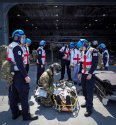You are using an out of date browser. It may not display this or other websites correctly.
You should upgrade or use an alternative browser.
You should upgrade or use an alternative browser.
Aircraft Carriers III
- Thread starter Jeff Head
- Start date
Jura The idiot
General
LOL it's been some time:
Aircraft Carriers II (Closed to posting) Mar 25, 2014
"Have you heard of shipborne rolling vertical landing (SRVL) yet? In case you haven't (as me, of course check this:
check this:
guess now it's time again for
What is Shipborne Rolling Vertical Landing?
September 17, 2018
Aircraft Carriers II (Closed to posting) Mar 25, 2014
"Have you heard of shipborne rolling vertical landing (SRVL) yet? In case you haven't (as me, of course
guess now it's time again for
What is Shipborne Rolling Vertical Landing?
September 17, 2018
The Shipborne Rolling Vertical Landing (SRVL) is a British endeavour—a capability at least a decade in the making—that will allow pilots to return to ship with more stores on the aircraft after a mission.
It is a process designed to land jump-jet aircraft that uses both the vertical thrust from the jet engine and lift from the wings, thus maximising the payload an aircraft can return with and stopping the financial waste that comes with dropping expensive weaponry in the sea in order to land vertically.
Since June, The F-35 Patuxent River Integrated Test Force (ITF) team has focused on live flying workups refreshing their skills on day and night field carrier landing practices, ski jump takeoffs and vertical landings in preparation for the arrival of HMS Queen Elizabeth.
The team also conducted rolling vertical landings in preparation for another unique British development, according to a recent release.
“[Rolling vertical landings] are an important phase of the workups because another unique aspect of going to the Queen Elizabeth Class carrier is that we will be conducting experimental testing of a novel recovery landing technique—the Shipborne Rolling Vertical Landing” said Royal Air Force Sq. Ldr. Andy Edgell, FOCFT (FW) lead test pilot at the Pax River ITF.
“SRVL tests are truly experimental. It involves landing a fast jet onto an aircraft carrier with forward relative speed but without the braking assistance typically provided by an arresting gear and hook. It’s going to be a really rewarding moment for British aviation to watch that procedure actually take place.”
It can also reduce the level of wear on the lift engines and extend their operational life. Similarly, it can reduce the amount of wear upon the deck surface of a carrier caused by the downward jet exhaust from vertical landings.
Well there were some issues with the paint on the sides of the ship during build, it was thought to have been applied incorrectly and rectified before completion. I can only presume the paint was a new more durable formulation that needs more than just a team of sailors hanging over the side with rollers and brushes,,,Nice photos Obi Wan!!..I'd like to know if the Royal Navy contracted side cleaners to keep the ship looking so pristine. Or do they use a special paint? Curious.
 Paint technology has moved on from what it was, Paint for the Marine environment especially so.
Paint technology has moved on from what it was, Paint for the Marine environment especially so.Jura The idiot
General
Jul 24, 2018
After short deployment pause, USS Harry S. Truman returns to US 6th Fleet operations
well,"But from the Navy’s leadership down to the strike group, no one is saying what will happen next ― and that’s the point, officials say."
:
The Truman is back in Norfolk — but what’s next after the non-homecoming?
After short deployment pause, USS Harry S. Truman returns to US 6th Fleet operations
US Navy aircraft carrier Harry S. Truman has resumed operations in the US 6th Fleet area of operations after returning to its Norfolk home in July for a month-long deployment pause.
The Harry S. Truman Carrier Strike Group (CSG) initially deployed to the European theater April 11, 2018, and returned to its homeport Naval Station Norfolk July 21, 2018, for what the navy termed as an extended working port visit.
The pause in what was usually a seven-month deployment is part of a new dynamic force employment concept which will allow the US Navy to be operationally unpredictable while remaining strategically predictable.
“We are thrilled to have the Harry S. Truman Carrier Strike Group back in the US 6th Fleet area of operations and look forward to continuing to work with Rear Adm. Gene Black and his team as we conduct the full spectrum of maritime operations,” said Vice Adm. Lisa M. Franchetti, commander of US 6th Fleet, headquartered in Naples, Italy.
The strike group got underway Aug. 28, completing training exercises and carrier qualifications in the Atlantic, to include participating in with the Nimitz-class aircraft carrier USS Abraham Lincoln (CVN 72) and bilateral operations with the Royal Canadian Navy.
The strike group which departed Norfolk, includes the flagship Nimitz-class aircraft carrier USS Harry S. Truman (CVN 75); the nine squadrons of Carrier Air Wing (CVW) 1; Ticonderoga-class guided-missile cruiser USS Normandy (CG 60); and Arleigh Burke-class guided-missile destroyers of Destroyer Squadron (DESRON) 28, USS Arleigh Burke (DDG 51) and USS Forrest Sherman (DDG 98). Other Harry S. Truman CSG assets operating in the region include Arleigh Burke-class guided-missile destroyers USS Bulkeley (DDG 84) and USS Farragut (DDG 99).


















